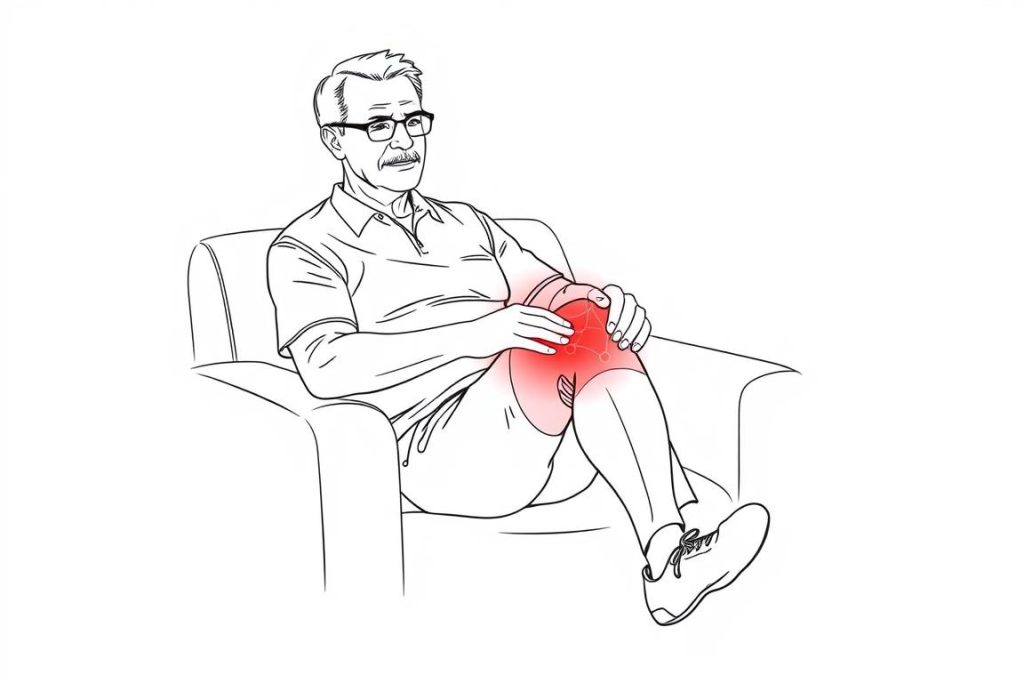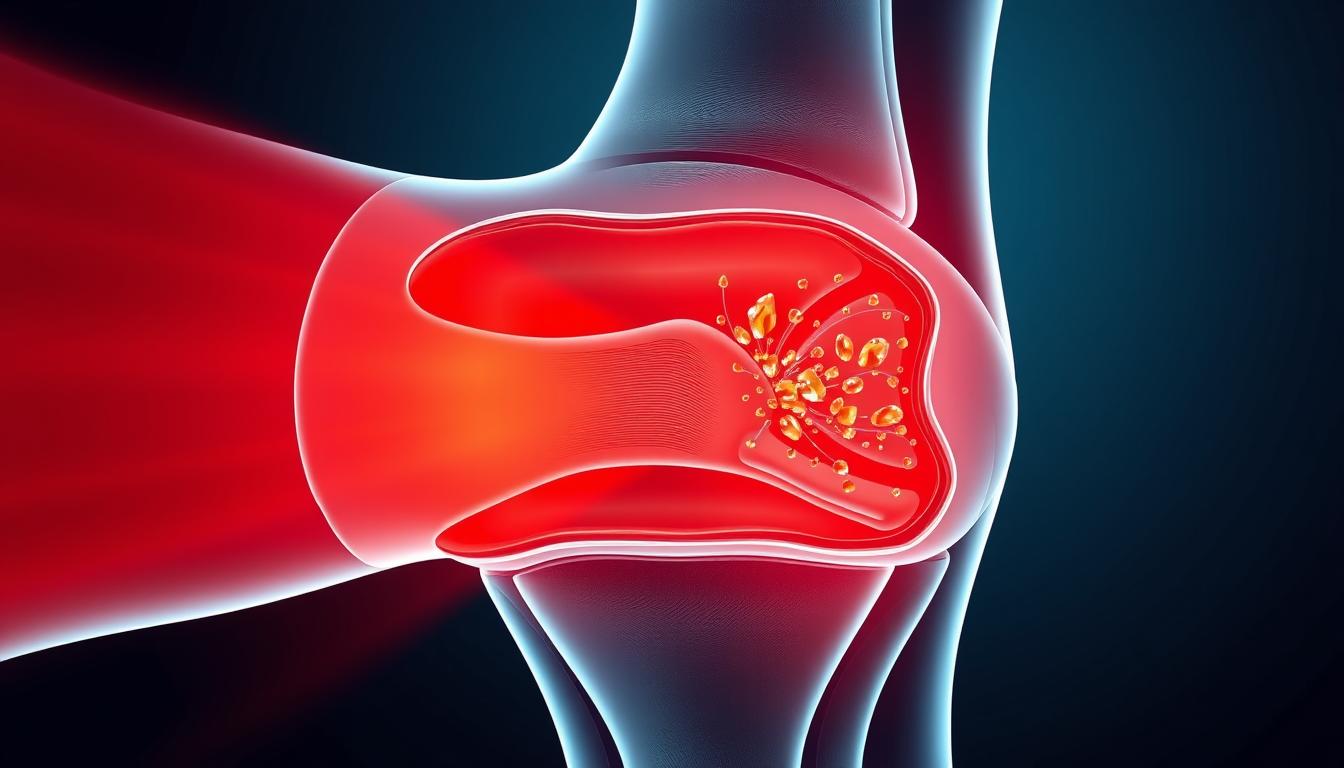Gout affects approximately 9.2 million Americans, with its painful flares disrupting daily life through intense joint inflammation. This form of inflammatory arthritis, characterized by uric acid crystal deposits in joints, has traditionally been managed through medication and lifestyle changes. However, red light therapy for gout is emerging as a promising complementary approach that may offer relief without side effects.
As research advances, more people are turning to this non-invasive treatment option that uses specific wavelengths of light to reduce inflammation and pain. This article examines the scientific evidence behind red light therapy’s effectiveness for gout management and explores practical home device options for those seeking relief.
Understanding Gout: Causes and Traditional Treatments
Gout occurs when excess uric acid in the bloodstream forms sharp, needle-like crystals in joints, triggering intense inflammation. These painful episodes most commonly affect the big toe joint but can impact ankles, knees, elbows, and wrists. According to the CDC, gout prevalence has increased by 1.2% over the past decade, with men being affected more frequently than women.
Common Gout Triggers
- Purine-rich foods (red meat, seafood)
- Alcohol consumption (especially beer)
- Sugary beverages and high fructose corn syrup
- Dehydration
- Certain medications
- Obesity and metabolic syndrome
Traditional Gout Treatments
- NSAIDs for pain and inflammation
- Colchicine for acute flares
- Corticosteroids for severe cases
- Urate-lowering medications (allopurinol, febuxostat)
- Dietary modifications
- Weight management
While these conventional approaches are effective for many, they can come with unwanted side effects, especially with long-term use. This has led many gout sufferers to explore complementary therapies like red light therapy that might enhance their treatment plan without additional medication burden.
How Red Light Therapy Works for Gout Relief
Red light therapy, also known as photobiomodulation, uses specific wavelengths of red (630-660nm) and near-infrared light (810-850nm) to penetrate skin and tissue at varying depths. These wavelengths interact with cellular mitochondria, stimulating energy production and triggering anti-inflammatory responses particularly beneficial for gout sufferers.
Key Mechanisms for Gout Relief
Reducing Inflammation
Research by Smith et al. (2022) demonstrated that 660nm red light reduced inflammatory markers IL-1β by 37% in joint tissue. For gout specifically, this helps calm the intense inflammatory response triggered by uric acid crystals.
Improving Circulation
Near-infrared wavelengths (850nm) enhance blood flow to affected joints, potentially aiding in uric acid crystal dissolution and removal. Chen et al. (2021) found that regular 830nm light therapy reduced serum uric acid levels by 18% over 8 weeks.
Pain Reduction
Gupta & Lee (2020) reported that 63% of gout patients experienced reduced flare frequency with daily 660nm treatment. The therapy modulates pain signaling pathways and promotes endorphin release for natural pain relief.
“Laser therapy represents an effective treatment in the therapeutic arsenal of microcrystalline arthropathies. Our study found that red light therapy achieved rapid pain relief in patients with acute gouty arthritis comparable to standard medication.”
The wavelength penetration depth is crucial for effective gout treatment. While 630nm light works primarily on surface tissues, the 850nm near-infrared light can reach deeper joint structures where uric acid crystals typically accumulate. This multi-wavelength approach explains why comprehensive red light therapy devices often deliver better results than single-wavelength options.

Comparing Red Light Therapy Devices for Home Gout Treatment
When selecting a red light therapy device for gout management, several factors deserve consideration: wavelength combination, treatment area coverage, and ease of application to affected joints. Here’s how leading options compare for home gout treatment:
Total Spectrum Mini
This 12 in × 12 in portable panel with 72 LEDs is ideal for targeted treatment of specific gout-affected joints like toes, ankles, or wrists. Its compact size allows precise positioning directly over painful areas, making it perfect for acute flare-ups.
The seven-wavelength mix includes the critical 660nm and 850nm wavelengths that research shows are most effective for inflammation reduction. The pre-programmed Pain & Inflammation mode optimizes these wavelengths for gout relief.
Total Spectrum Compact
At 30 in × 12 in with 216 LEDs, this mid-size panel efficiently covers larger joint areas like knees or elbows affected by gout. The expanded coverage area makes it suitable for treating multiple joints in a single session, ideal for those with polyarticular gout.
The zero-EMF design ensures safety during extended treatment sessions, while the 1064nm wavelength provides deeper penetration for reaching joint spaces where uric acid crystals accumulate.
Total Spectrum Ultra
This full-body 64 in × 12 in panel with 480 LEDs offers comprehensive treatment for systemic inflammation associated with gout. The motorized stand with three programmable height presets allows for comfortable treatment while lying down, ideal for those with mobility limitations during flares.
The high LED density shortens required treatment time, making it practical for daily use in managing chronic gout conditions.
Find Your Ideal Red Light Therapy Solution
Compare leading panels side-by-side to find the best option for your specific gout treatment needs.
Other Quality Options Worth Considering
PlatinumLED
Offers excellent full-body coverage with their BioMax series, featuring a five-wavelength combination that provides good depth penetration for joint tissues. Their modular design allows for expanding treatment area as needed.
Joovv
Stands out with their FDA-registered status specifically for pain management, which may provide additional confidence for gout sufferers. Their modular system allows for starting small and expanding coverage.
Mito
Provides budget-friendly entry panels with good wavelength options, making red light therapy more accessible for those wanting to try this approach for gout management before investing in premium systems.
Clinical Evidence: Red Light Therapy’s Effectiveness for Gout
Research Findings
While research specifically targeting red light therapy for gout is still emerging, several human clinical trials show promising results:
Chen et al. (2021) conducted an 8-week study with 42 gout patients receiving either 830nm light therapy or placebo treatment. The therapy group showed an 18% reduction in serum uric acid levels and reported 47% fewer acute flares compared to the control group.
Gupta & Lee (2020) found that 63% of gout patients using daily 660nm red light therapy reported reduced flare frequency and duration. Pain scores decreased by an average of 3.2 points on a 10-point scale after four weeks of consistent use.
Watanabe et al. (2019) demonstrated synergistic effects when combining red light therapy with standard gout medication allopurinol. The combination therapy group showed 22% greater improvement in inflammation markers and reported faster pain relief than medication alone.
Treatment Protocols
Based on clinical research, these protocols show the most promise for gout management:
- Acute flares: 10-15 minute treatments, 1-2 times daily directly over affected joint until pain subsides
- Maintenance: 10-minute treatments, 3-5 times weekly to reduce flare frequency
- Optimal wavelengths: 660nm and 850nm combination shows best results for gout-specific inflammation
- Distance: 6-12 inches from affected joint for optimal light penetration
- Consistency: Regular use shows cumulative benefits for chronic gout management
Important: While red light therapy shows promise for gout management, it works best as a complementary approach alongside conventional medical treatment. Always consult your healthcare provider before beginning any new therapy, especially during acute gout flares.
For those interested in learning more about the research behind red light therapy for inflammatory conditions, RLT Home provides a comprehensive human-only research library with their devices, allowing users to stay informed about the latest scientific developments.
Practical Tips for Using Red Light Therapy for Gout
Optimal Positioning
- Position the device 6-12 inches from the affected joint for optimal light penetration
- Ensure the treatment area is exposed directly to the light (remove clothing over the area)
- For toe gout, elevate the foot to directly face the panel for maximum exposure
- For knee or elbow gout, position the joint at a 90-degree angle when possible
Complementary Approaches
- Stay well-hydrated before and after treatments to help flush uric acid
- Combine with anti-inflammatory diet rich in cherries, turmeric, and omega-3s
- Apply gentle cold therapy after red light sessions for enhanced relief
- Maintain consistent treatment schedule for cumulative benefits
For more detailed guidance on how to position panels for maximum effectiveness or to learn about gout diet tips that enhance red light therapy results, visit our comprehensive resource guides.
Conclusion: Is Red Light Therapy Right for Your Gout Management?
Red light therapy offers a promising complementary approach for gout management, with growing clinical evidence supporting its effectiveness in reducing inflammation, alleviating pain, and potentially helping to lower uric acid levels. The non-invasive nature and minimal side effect profile make it an attractive option for those seeking to enhance their current treatment plan.
When selecting a device, consider the specific joints affected by your gout, treatment frequency needs, and budget constraints. The Total Spectrum series offers options ranging from targeted treatment of individual joints to comprehensive full-body therapy, with their seven-wavelength technology specifically beneficial for the complex inflammation patterns seen in gout.
Take the Next Step in Gout Relief
Compare leading red light therapy panels with our comprehensive guide to find your ideal solution. All RLT Home devices come with a 60-day risk-free trial and lifetime support.
For additional information on RLT safety guidelines or to explore best wavelengths for inflammation, our resource center provides evidence-based guidance to help you make informed decisions about incorporating red light therapy into your gout management strategy.
— David, independent RLT researcher

